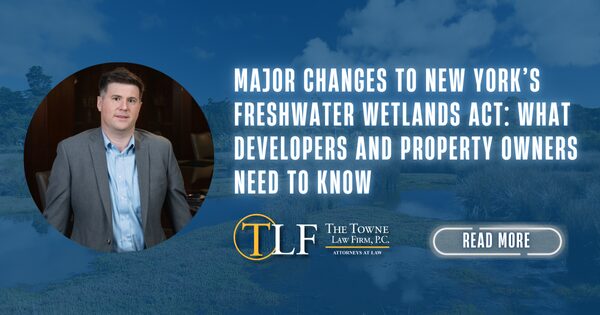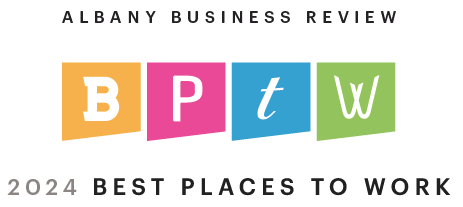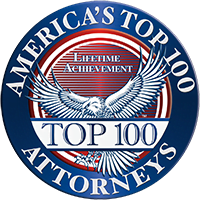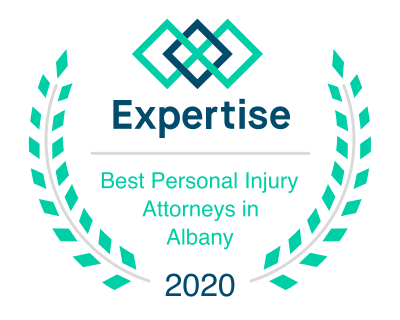Major Changes to New York’s Freshwater Wetlands Act: What Developers and Property Owners Need to Know
Sep 25, 2024ALBANY, NY | In a significant move toward enhancing environmental protection, the New York State Legislature made substantial amendments to New York’s Freshwater Wetlands Act (FWA) on April 9, 2022. These changes expand the jurisdiction of the New York State Department of Environmental Conservation (NYSDEC), potentially affecting thousands of smaller freshwater wetlands and wetlands deemed of “unusual importance.” As a result, an estimated one million acres of freshwater wetlands, which were not inventoried on official NYSDEC maps in the 1980s, may now fall under state protection.
The NYSDEC is in the final stages of finalizing new regulations prompted by these amendments, which will introduce important updates to the management and protection of wetlands across the state. Two key changes under consideration include:
- Extension of Adjacent Areas: Under the new regulations, the current 100-foot regulated buffer zones surrounding wetlands may be expanded to 300 feet. This change significantly increases the area subject to regulation, potentially affecting a broader range of development projects.
- Regulation of Wetlands of Unusual Importance: The NYSDEC has elaborated on its plan to regulate wetlands that have been identified as having “unusual importance,” which could include wetlands with unique environmental, ecological, or social value. This category of wetlands could receive heightened protection, further restricting certain activities in and around these areas.
While these proposed regulations are aimed at bolstering New York’s environmental protections, they may also pose new challenges for developers and property owners. The expanded definition of regulated wetlands means that the permitting process will likely become more intricate, requiring more time, resources, and compliance efforts. Property owners who may not have previously needed a permit for certain activities may now find themselves navigating a more complex regulatory landscape.
What Developers and Property Owners Should Do
It is critical for developers, property owners, and all other stakeholders to closely review these proposed regulations and stay informed throughout the regulatory process. Although the NYSDEC has closed the public comment period, individuals and organizations still have several options to participate or express their concerns.
Here are a few steps stakeholders can take:
- Review the Draft Regulations: Familiarize yourself with the proposed changes, particularly if you own or plan to develop property near wetlands. Understanding how the new regulations could impact your project is essential for avoiding costly delays and ensuring compliance.
- Submit Late Comments (If Permitted): Although the official public comment period is closed, stakeholders can sometimes submit late comments, but it is at the discretion of the DEC whether or not to consider them. It’s best to reach out to the DEC and request whether late submissions will be accepted.
- Engage in Advocacy: Stakeholders can engage in advocacy efforts by reaching out to government officials or state legislators to express concerns or suggestions regarding the proposed rules. Legislators or other influential bodies might be able to push for changes or further consideration of certain issues.
- Seek Judicial Review: If a stakeholder believes the DEC’s rule-making process was flawed or that the final rules are illegal, arbitrary, or capricious, they may challenge the rule-making process through judicial review. Under New York law, a challenge can be brought under Article 78 of the New York Civil Practice Law and Rules (CPLR) to review the administrative decision.
- Monitor for Revisions or Final Rule Publication: After the comment period closes, the DEC will review the comments and may revise the proposed rule. Stakeholders can monitor the New York State Register or the DEC’s website for updates, including the publication of any revised rules or the final rule.
- Petition for Rule Amendments: Once the rule is finalized, stakeholders can petition the DEC to amend the rule at a later date. New York’s State Administrative Procedure Act (SAPA) allows for petitions to amend or repeal an existing rule.
- Consult with Legal and Environmental Experts: Given the increased complexity of the permitting process, working with legal and environmental professionals who are familiar with New York’s wetlands regulations is more important than ever. They can provide guidance on compliance and help you navigate the regulatory requirements.
Conclusion
The 2022 amendments to New York’s Freshwater Wetlands Act represent a significant step forward in protecting the state’s vital wetland ecosystems. However, they also introduce new hurdles for development and land use, especially for those operating in or near newly regulated areas. By staying informed, participating in the public comment process, and seeking expert advice, stakeholders can help ensure that these regulations support both environmental stewardship and economic growth.
For more information on how these changes may affect your property or development plans, or for assistance navigating the permitting process, contact The Towne Law Firm, P.C. Our experienced environmental law team is here to guide you through the complexities of New York’s evolving wetlands regulations.
Written by TLF Partner, Mark Houston. Contact Us Today!
The Towne Law Firm, P.C. is a reliable resource for clients with regard to compliance with the broad spectrum of environmental law regulation and enforcement issues that affect their businesses.
Learn More Share














